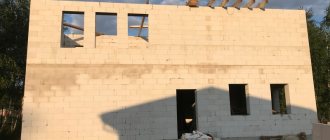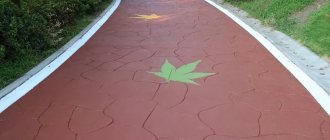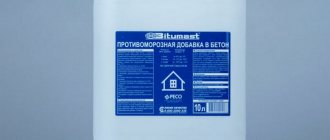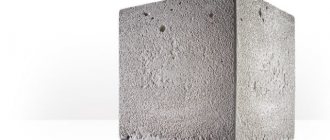Concrete is a very durable building material. Thanks to its strength, it is so widely used in construction and repair work.
But concrete also has its weaknesses:
- low tensile strength during bending;
- tendency to shrink;
- formation of cracks;
- low impact strength, due to which it splits and becomes cracked under impact load;
- porous structure that can absorb water, making concrete susceptible to mold and mildew.
There are various ways to make concrete flawless: special additives added to the solution give it density, viscosity, and water-repellent properties. Depending on what additive is used, concrete with different characteristics can be obtained.
To increase the strength of concrete structures, including bending and tensile strength, reinforcement is used using anti-shrink mesh or reinforcement cage.
But reinforcing concrete in this way is an expensive and time-consuming undertaking.
A modern alternative to reinforcement is the use of special fiber for concrete, which is added to the concrete solution. Due to its properties, fiber is called micro-reinforcement and is considered as an alternative to traditional reinforcement.
General properties of fiber for concrete. What is fiber fiber used for?
Fiber refers to fibers made from steel, basalt, glass, polymers, and polypropylene. These fibers can have different lengths (from 2-3 mm to several centimeters), thickness, configuration, cross-sectional shape, and surface texture.
Fiber is added to concrete solutions for any purpose to impart strength, impact strength, eliminate shrinkage and prevent cracking, increase durability and abrasion resistance. Concrete with the addition of fiber becomes waterproof, frost-resistant (frost resistance can increase up to 100 cycles), and heat-resistant.
Important!
The choice of type and size of fiber depends on the purpose of the concrete.
Short-length fiber (3-6 mm) is added to plaster mortars to ensure the smoothness of the plastered surface. Fiber of long fiber length is added to heavy concrete.
Concrete with the addition of fiber fiber is called fiber-reinforced concrete.
Types of fiber fiber
"Fiber" translated from English means "fiber". Indeed, in appearance these are threads of a certain diameter and length, made of various materials.
Depending on the material, concrete fiber is divided into five main types:
- steel;
- polymer;
- basalt;
- polypropylene;
- glass.
Important!
In modern construction, the addition of fiber to concrete solutions is desirable even in cases where reinforcement is used in the structure, but it is especially important to strengthen in this way concrete intended for pouring structures that will be subject to increased loads (foundations, floor screeds, road surfaces).
Steel fiber
The main advantage of this type of fiber is its low cost. It has been used in European countries for many years, and appeared in Russia not so long ago.
Form and properties
Steel fiber for concrete is pieces of low-carbon steel wire with a diameter of 0.7-1.2 mm and a length of 25 to 60 mm.
In cross-section it can be round or triangular, and in configuration it can resemble an arc or bracket, or have a wave-like shape. To improve adhesion to concrete, the fiber has a rough surface.
Dosage and method of addition
Steel fiber is dosed depending on the purpose of the concrete and the loads that the structure will experience during operation:
- for minor loads, 15-30 kg of fiber per 1 cubic meter of concrete is sufficient;
- at medium loads, add up to 40 kg of material per 1 cubic meter of solution;
- at high loads, the consumption of steel fiber increases to 75, and in some cases up to 150 kg per cubic meter of solution.
Steel fiber is added to the solution during mixing or after, to the finished concrete mixture. It is poured in small portions and mixed thoroughly.
Important!
Adding fiber increases the mixing time of the solution by 15%.
Advantages and disadvantages of steel fiber
Thanks to the addition of steel fiber, which forms a three-dimensional frame in concrete, the structure acquires additional characteristics:
- tensile strength during bending increases by 2 times;
- the ultimate deformation increases by 20 times;
- increased resistance to shock loads;
- frost resistance and water resistance increase.
Steel fiber is used in civil engineering when pouring foundations, screeds and can replace reinforcement. Compared to reinforcement, adding steel fiber is a simple and convenient process. There is no need to lay out the fittings and install fasteners; time and labor costs are saved.
Important!
Steel fiber is compatible with other additives.
Disadvantages of steel fiber:
- high weight;
- adhesion to concrete is less strong than other types of fiber;
- susceptibility to corrosion;
- Due to concrete erosion, steel fibers may come out over time.
Polymer fiber (PAN fiber)
Polymer fiber is fibers made of a polymer material with a length of 3, 6, 12, 18, 24 mm and above.
Scope of application of fiber in concrete
Polymer fiber is used in the following types of concrete structures:
- self-leveling floors;
- airfield slabs;
- hydraulic structures;
and is also added to construction, repair and plaster mortars.
Properties
Advantages of polymer fiber:
- not subject to corrosion;
- light;
- increases the strength of concrete;
- has high resistance to elevated temperatures, salts, alkalis, acids;
- safe for the environment and humans.
The main advantage of polymer fiber is that it gives plasticity to concrete.
How to use fiber fiber
Polymer fiber can be added directly to dry cement before mixing the solution.
How much fiber to add to concrete solution
The proportions of addition and the choice of fiber length depend on the purpose of the concrete:
- in heavy concrete, fiber 12–40 mm long is used, in reinforced concrete in the amount of 2–2.7 kg per cubic meter, in unreinforced concrete – 0.7–1 kg per cubic meter;
- in cellular concrete, fiber 12 mm long is used in a dosage of 0.1% of the mass of foam concrete;
- Fiber 4 mm long is added to the plaster in the amount of 0.9 kg per cubic meter of solution.
Glass fiber
Glass fiber is made from alkali-resistant glass fiber with a diameter of 10-15 microns and a strength of up to 2000 MPa.
Once in the solution, glass fiber breaks down into individual fibers during mixing.
Properties of glass fiber
Glass fiber gives concrete the following qualities:
- reduction of cracking;
- reduction of shrinkage;
- increase in strength and elasticity.
Glass fiber is resistant to aggressive environments (except alkaline environments).
Where is it used?
Glass fiber is used:
- in screeds of any thickness;
- in prefabricated concrete structures;
- in construction mixtures.
Important!
Concrete with the addition of glass fiber sets and hardens faster, this must be taken into account when working. Adding a plasticizer will help extend the life of the solution.
Basalt fiber
Basalt fiber refers to pieces of basalt fiber, which can have a length from 1 to 150 mm. The fiber has a diameter of 16-18 microns, it is resistant to water, acids, alkalis, strong, elastic.
Basalt fiber, unlike metal fiber, does not corrode, is 3 times lighter and has a surface area 25 times larger. Basalt fiber has high adhesion and the same coefficient of thermal expansion as concrete.
Qualities of concrete with basalt fiber
The addition of fiber gives concrete the following characteristics:
- Impact strength increases 5 times;
- resistance to cracking increases 3 times;
- splitting strength increases by 2 times;
- increased abrasion resistance (up to 300%) and durability;
- tensile strength during bending increases up to 300%;
- frost resistance increases by 2 times;
- due to the absence of cracks, corrosion resistance increases to 500%;
- water resistance increases to 150%;
- shrinkage is reduced;
- Impact strength increases.
Where is it used?
Basalt fiber is used for the manufacture of earthquake-resistant structures, explosion-proof objects, military structures, and complex radio-transparent structures.
Due to the unmatched abrasion resistance that concrete gains when basalt fiber is added, it is widely used for making screeds.
Add method
Basalt fiber is soaked in water and then added to the solution when mixing.
Important!
The addition of any type of fiber makes the concrete solution more viscous and less fluid, so it is important to combine the use of fiber with the use of a plasticizer, which saves cement, water, the cost of concrete compaction and increases the fluidity of the solution.
Polypropylene fiber
Polypropylene fiber is a reinforcing microfiber used as an alternative to concrete reinforcement. This is the most common type of reinforcing fiber.
Form and properties
This type of fiber is made from a synthetic substance - polypropylene.
Polypropylene fibers are formed by extrusion or drawing and cut into pieces of different lengths.
The length of polypropylene fiber fibers is from 6 to 40 mm.
Fiber has significant strength and elasticity, is resistant to aggressive, including alkaline, environments and corrosion, and is also fire-resistant.
A significant advantage of polypropylene fiber is its lightness and large surface area (1 kg of polypropylene fiber contains about 1 million fibers).
Fiber in concrete mixtures is combined with any other additives:
- plasticizers and superplasticizers;
- accelerators;
- hydrophobizing additives;
- antifreeze additives.
Polypropylene fiber can be made from primary or secondary raw materials. In the first case, the quality of the fiber is higher.
What is polypropylene fiber used for?
Adding fiber fiber to the solution compensates for the tensile stresses of its lower layer and tensile stresses due to loads and provides the following advantages of fiber-reinforced concrete over conventional concrete:
- preventing mixture separation;
- increase in compressive and tensile strength during bending;
- increasing the durability of concrete;
- reduction of abrasion of the concrete surface;
- increased impact strength (when impacted, the concrete does not crack, but only a dent appears);
- elimination of shrinkage;
- prevention of crack formation;
- increasing resistance to frost;
- increasing the water resistance of concrete.
Additional properties of polypropylene fiber
The solution with fiber becomes thicker, holds its shape and does not flow, therefore allowing the plaster to be applied in a thicker layer.
In what cases is polypropylene fiber used?
Polypropylene fiber forms a three-dimensional reinforcing frame in concrete, so its use is justified in the manufacture of:
- industrial floors;
- floor coverings;
- screed;
- concrete floors;
- concrete roads;
- sidewalks;
- foundations.
Consumption of polypropylene fiber fiber
The fiber is very light and very economical. In general, the ratio of fiber to concrete is 900 g per 1 cubic meter of mixture. Depending on the area of application, the dosage of fiber may vary:
- For the manufacture of industrial floors and concrete road surfaces, fiber of 12, 20 or 40 mm in size from 1 kg per 1 m3 is used.
- For screeds and heated floors, from 0.9 to 1.5 kg of fiber 12 or 20 mm long is used per 1 cubic meter of mixture.
- In reinforced concrete structures, concrete is used with the addition of 0.9 kg per 1 cubic meter of concrete, fibers 12 or 20 mm long.
- For cellular concrete, the amount of fiber fiber measuring 12, 20 or 40 mm is from 0.9 kg per cubic meter of concrete.
- For self-leveling floors, plaster and repair mortars, polypropylene fiber of 6 or 12 mm in size is used at the rate of 1 kg per cubic meter of solution.
- For small-piece products with complex shapes, fiber 6 or 12 mm long is needed in a dosage of 0.9 kg per 1 m3 of mixture.
- When making paving slabs, add 0.9 to 1.5 kg of fiber 6-12 mm long per 1 cubic meter of cement mortar to the solution.
How to use polypropylene fiberglass
Fiber is easy to use.
How to add fiberglass to concrete mortar?
There are three ways:
- Fiber is added to the dry components of the solution (cement and fillers), mixed thoroughly with a construction mixer or in a concrete mixer, then water is added.
- Fiber is added to part of the mixing water, mixed well to distribute the fibers, and added to the concrete mixture during the mixing process.
- The fiber is poured into the solution in small portions during mixing. After adding each portion, mix for 5 minutes before adding more fiber.
Important!
The effectiveness of the fiber directly depends on how well it is distributed in the concrete solution, so the mixing time should be increased by 15%.
Video: Mixing mortar with fiber
FIBER X MESH
This macrofiber takes the form of finely chopped woven polypropylene ropes. This complex shape allows you to obtain excellent adhesive properties, and it is also convenient for creating various types of screeds and concrete coatings. FIBER X MESH was created as a more modern, lightweight and resistant to any aggressive environment substitute for steel fiber.
For comparison, one cube of fiber-reinforced concrete with FIBER X MESH contains 22 times more reinforcing elements than a cube of concrete with steel fiber.
We produce this fiber in 3 sizes - 23, 39, and 54 mm. Fiber sizes 23-39 are used for concrete pouring layer thicknesses up to 100 mm. Fiber sizes 39-54 are used when this parameter is exceeded. Thus, 39 mm macrofiber is universal for reinforcing concrete with fiber. Its average consumption during work is 1-3 kg per cubic meter of concrete mixture. For more detailed information on working with FIBER X MESH, study the “technical sheet” of its application. There you can also find recommendations for use and the accompanying test certificates.
What to look for when buying fiber
Buying low-quality fiber is not only a waste of money, but also a risk of ruining the structure. Concrete structures are manufactured with strength and long service life in mind. The use of low-quality materials can lead to significant losses.
For example, you can find handicraft polypropylene fiber on the market. In appearance, it differs little from factory fiber, but is manufactured in violation of technology. High-quality fiber contains a component called lubricant. It prevents fibers from clumping and promotes their uniform distribution in the solution. The fake fiber will crumple, and the formation of a three-dimensional frame in the thickness of the concrete will not occur, which means that the concrete will not receive the properties that were expected when the fiber was added. By “saving” a few rubles, you can incur significant losses.
To avoid such situations, purchase fiber from trusted manufacturers from reliable suppliers.
Advantages
People are often interested in the question of how the properties of finished products change when fiber is used, and how does reinforcing fiber affect the class of concrete?
Below are the arguments for the use of fiber fibers:
- The service life increases by tens of years.
- The mixture consumption becomes lower.
- The product is more resistant to moisture and mechanical damage.
- The structure hardly shrinks.
- Increases fire resistance class.
- Prevents cracks.
Surprisingly, there is even glue with reinforcing fibers. Fiber fiber helps to obtain the most durable and high-quality products without huge costs. For this reason, the use of such a component is 100% justified and makes it possible in the future not only to be proud of the gorgeous result, but also to save money by postponing repair work for many years.
Is fiber needed for screeding, and which one should I use?
When making screeds, it is important to maintain a balance between two mutually exclusive tasks:
- ensuring high strength (which is directly proportional to the thickness of the screed);
- minimum thickness of the screed (to save materials and maintain the ceiling height as much as possible).
The addition of polypropylene fiber helps to solve this contradiction. It is recommended to add it both to the solution for wet screed and to the mixture for semi-dry screed, regardless of whether mesh reinforcement is used.
Fiber fiber not only increases the strength of the screed and reduces its abrasion, but also prevents shrinkage and cracking, increases the impact strength of the surface, preventing cracking and chipping during operation. The screed with the addition of fiber fiber is strong and durable.
Video: Screed with fiber is stronger than with reinforcement!
Technology of use
All stages of creating fiber-reinforced coatings are so worked out and verified that obtaining the correct result without defects is possible even without turning to professionals, when working independently. To fill a reinforced screed, you must have the following tools and materials:
- cement, sand, water, plasticizer, fiber;
- damper tape;
- level: laser or regular water level;
- profile for beacons;
- usually, tape measure, ruler;
- drill with a nozzle for mixing the solution;
- roller for leveling semi-dry screed (if necessary);
- screwdriver, fastening materials (screws);
- construction knife, trowel and spatula.
The stages of work are as follows:
- First you need to prepare the base for the base screed. To do this, you need to remove all debris, dirt and dust, and carry out wet cleaning. The surface should become dry and clean. Next, you need to seal all the cracks and irregularities with putty, and go over the base with a primer for the best adhesion.
- Find the highest point of the future screed, use a level to mark a line along all the walls.
- Install beacons that will be used to level the surface of the screed. Lighthouses are made from profiles. They are fixed at the required height with gypsum mortar or cement. After leveling, the beacons will be flush with the surface.
- A special damper tape is glued along the entire perimeter of the room at the bottom of the walls and around columns and podiums for plumbing fixtures, which performs a compensating function when concrete expands as a result of temperature changes, for example, when a “warm floor” is turned on. Along with fiber, it prevents deformation and cracking of the screed when drying.
- Insulating materials and, if necessary, reinforcing mesh are laid, thermal insulation and a heating circuit for “warm floors” are installed.
- The solution is being prepared. For one part of the volume of cement, take 3 parts of the volume of clean sand, from 300 to 900 g of fiber fibers. All ingredients are mixed, then water and plasticizer are added to the dry base mixture. If the solution is mixed thoroughly, you will get a high-quality fiber cement screed.
- The prepared reinforced solution is applied to the prepared surface in a thin layer of 3-5 cm. It should be taken into account that the semi-dry screed “shrinks” by 1 cm after compaction.
- The screed is leveled by sliding the rule along the guide beacons, or the semi-dry screed is rolled with a special roller.
- Waiting for it to dry and gain strength. To do this, cover the finished screed with plastic wrap and moisten it with water once a day. Duration time: 1 week. The time for complete hardening is 2-3 weeks.
The reinforced screed is ready. You can begin laying the final decorative coating.
You will learn even more information about fiberglass for floor screed in the next video.
Tips for selecting reinforcing fibers
Each type of reinforcing fiber has its own advantages and disadvantages. The choice of reinforcing fiber directly depends on the purpose of the structures that will be made of concrete.
The quality of the material is of great importance, so you should carefully choose the manufacturer and seller of reinforcing fibers.
Polypropylene fiber fiber is a modern alternative to concrete reinforcement, which saves money, time and labor and provides concrete with increased strength, durability, resistance to external factors and other important characteristics. Today it is recommended to use fiber in almost any design. The effectiveness of additives depends on their correct selection and application.











